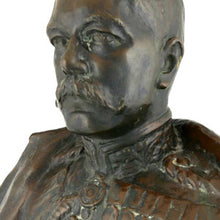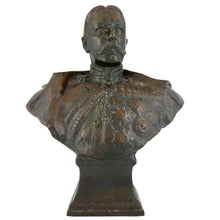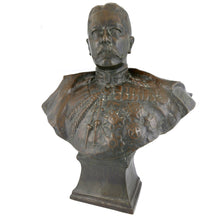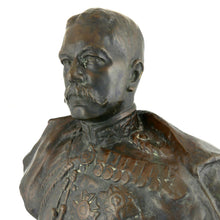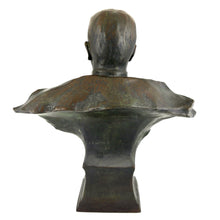Portrait Bust - Field Marshal Lord Kitchener of Khartoum, 1914
- Regular price
- £3,800
- Sale price
- £3,800
- Regular price
-
- Unit price
- /per
Adding product to your cart
Height: 46cm (18in)
Patinated bronze. Portrait bust modelled in field marshal’s full dress uniform with orders, decorations and medals. Raised on integral bronze socle. Signed and dated ‘Sydney March / 1914 / Elkington & Co’.
As a past provider of British military victories, Lord Kitchener in 1914 was expected to deal with the Germans in the same way he had with Dervishes in the Sudan and the Boers in South Africa. Previous portrayals of Kitchener by Sydney March for Elkington & Co reflected these achievements. Accordingly it may have seemed in the autumn of 1914 that another commercial opportunity was at hand to capitalize on Kitchener’s fame and popularity, when Prime Minister Herbert Asquith appointed him to the high profile post of Secretary of State for War with the task of recruiting a citizen army large enough to sustain a struggle of years against Imperial Germany.
Read more
Kitchener’s directive ‘Join Your Country’s Army’ and imperious features glaring down from countless recruiting posters proved a powerful instrument in urging 3 million men volunteer in the first two years of all out war. However at this stage in Kitchener's career he did not regard himself as junior to anyone so no longer attempted to please people in authority. Moreover he seldom bothered to follow the normal codes of polite behaviour with subordinates, except, of course, to his ever-present ADC, Oswald Fitzgerald. Kitchener was still regarded by the wider public as a victorious general, on a par with Wellington, yet by 1916 the Cabinet and Herbert Asquith, the Prime Minister, had lost faith in him. He said of Kitchener, behind his back, 'He is not a great man. He is a great poster'. On 5 June 1916 Kitchener sailed from Scapa Flow on a diplomatic mission to Russia in the armoured cruiser HMS Hampshire. Shortly before 1930 hrs and in gale conditions Hampshire struck a mine laid by U-75 (Curt Beitzen) and sank west of the Orkney Islands. Lord Kitchener, ‘Fitz’ and the rest of his staff, together with 643 of the crew of 655, were drowned or died of exposure. Kitchener’s body was never found. The survivors who caught sight of him in those last moments testified to his outward calm and resolution.
Sydney March (1876–1968) was the second of nine children, eight of whom became artists. Three of the March family became sculptors, Sydney, Elsie (1884-1974), and Vernon. The other five artists were Edward (1873-1941), Percival (b.1878), Frederick (b.1881), Dudley (1881-1962), and Walter (b.1889). The ninth sibling was a sister, Eva. Originally from Yorkshire the March family moved to London around the turn of the century when Sydney was enrolled at the Royal Academy Schools and where he was awarded the first prize medal for a model of a statue or group. Between 1906 and 1932, he exhibited thirteen times at the R.A., primarily portrait busts, statuettes, and equestrian statues. The March family established their own sculpture studio at Goddendene, Kent, in 1901, Sydney being responsible for royal portraits, including Queen Victoria, Queen Alexandra and George V, as well as for producing figures, busts and statues of leading personalities of the day. In the early 1920’s the March studio was honoured with a visit by members of the Royal Family. Sydney’s public works include statues of Colonel Bevington (Tooley Street, London Bridge, 1911) and Lord Kitchener (Calcutta, 1914; Khartoum, 1921, removed to Royal School of Military Engineering, Chatham, 1958). Among his portrait busts were Cecil Rhodes, Sir John French. March also executed a number of war memorials including Bromley Parish Church (1921) and the United Empire Loyalists Memorial (Hamilton, Ontario, 1929). Following the death of Vernon March in 1930, Sydney and his siblings completed the Canadian National War Memorial at Ottawa.






